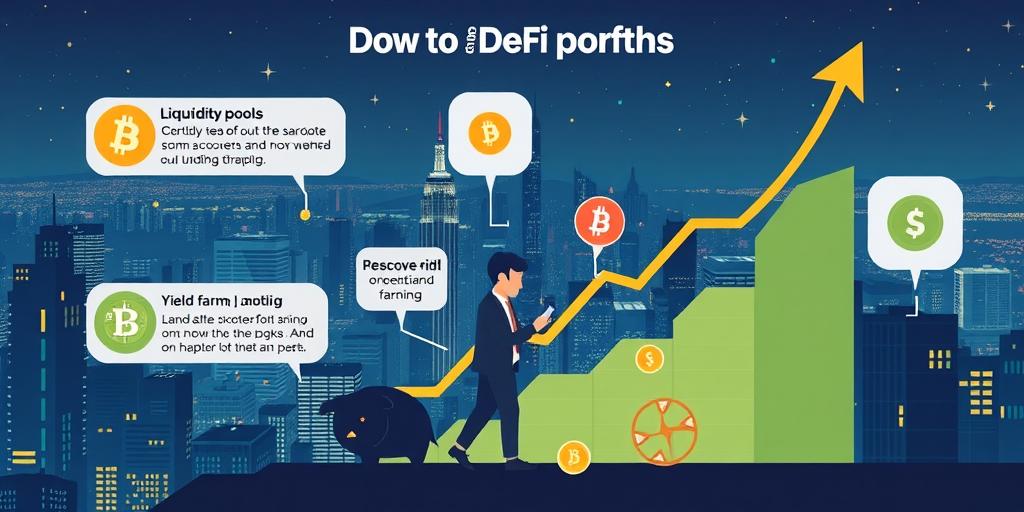Decentralized finance, or DeFi, has revolutionized the way people interact with financial services, offering a new frontier for maximizing yields in the dynamic crypto markets. DeFi strategies empower individuals to take control of their assets and earn passive income, potentially outperforming traditional financial instruments. This comprehensive guide delves into the world of DeFi, exploring strategies, platforms, and considerations for maximizing returns while navigating the inherent risks.
Introduction to DeFi
What is DeFi?
Decentralized finance is a rapidly evolving ecosystem built on blockchain technology, aiming to provide accessible and transparent financial services without relying on intermediaries like banks. DeFi applications range from lending and borrowing to trading and insurance, all facilitated through smart contracts that automate processes and ensure trustless interactions.
Benefits of DeFi
DeFi offers several advantages over traditional finance, including:
- Transparency: All transactions are recorded on a public blockchain, ensuring auditable and transparent operations.
- Accessibility: DeFi services are often available to anyone with an internet connection, removing geographical and financial barriers.
- Security: Smart contracts are designed to be tamper-proof, minimizing the risk of fraud or manipulation.
- Efficiency: Automation streamlines processes, reducing costs and delays associated with traditional intermediaries.
Yield Farming Strategies
Liquidity Providing
Liquidity providers contribute to the liquidity of decentralized exchanges (DEXs) like Uniswap by supplying trading pairs of cryptocurrencies. In return, they earn fees generated from trades on the platform, proportional to their share of the liquidity pool. This strategy involves locking up funds for a period, potentially impacting liquidity if the market shifts significantly.
Staking
Staking involves holding cryptocurrencies in a dedicated wallet to support the network’s operations. In return, stakers receive rewards in the form of native tokens or a share of the network’s transaction fees. This strategy is often employed for proof-of-stake (PoS) blockchains, where users are incentivized to validate transactions and secure the network.
Lending and Borrowing
DeFi protocols like Aave and Compound allow users to lend their cryptocurrencies to borrowers and earn interest. Conversely, borrowers can access loans using their crypto assets as collateral. This strategy offers potential for both lenders and borrowers to generate income or access funds without relying on traditional financial institutions.
Maximizing Yield with DeFi
Diversification
Diversifying across various DeFi protocols and strategies helps mitigate risk. By spreading assets across different platforms and earning mechanisms, users can reduce their exposure to any single protocol’s volatility or potential vulnerabilities.
Risk Management
DeFi involves inherent risks, including smart contract vulnerabilities, impermanent loss in liquidity pools, and market volatility. Implementing strategies like diversifying portfolios, using stop-loss orders, and monitoring smart contract audits helps mitigate these risks.
Compounding Interest
Compounding interest is a powerful tool for maximizing yield in DeFi. By reinvesting earned interest back into the same strategy, users can accelerate their returns over time. This strategy requires careful planning and monitoring to ensure consistent returns and avoid potential losses.
Popular DeFi Platforms
Uniswap
Uniswap is a popular decentralized exchange that allows users to trade cryptocurrencies directly with each other, eliminating the need for centralized intermediaries. Liquidity providers contribute to the platform’s liquidity pools and earn fees from trades.
Aave
Aave is a lending and borrowing protocol that enables users to earn interest on their cryptocurrencies by lending them to borrowers. Borrowers can access loans using their crypto assets as collateral, paying interest to lenders.
Compound
Compound is another lending and borrowing protocol that facilitates the lending of cryptocurrencies. Users earn interest on their deposits based on market demand and supply, while borrowers pay interest for accessing funds.
DeFi’s Potential for Growth
DeFi continues to evolve rapidly, with new protocols and strategies emerging regularly. Its accessibility, transparency, and potential for high returns make it an attractive option for investors seeking to diversify their portfolios and earn passive income.
Considerations for DeFi Investors
Despite its potential, DeFi also poses risks. Investors should carefully research and understand the protocols, risks, and strategies involved before investing. It’s crucial to diversify portfolios, implement risk management strategies, and stay informed about the evolving landscape of DeFi.
Future of DeFi
The future of DeFi is promising, with ongoing advancements in technology and regulations paving the way for increased adoption. DeFi has the potential to revolutionize financial services, offering innovative solutions for individuals and institutions alike. As the ecosystem matures and becomes more user-friendly, DeFi is poised to play a significant role in the future of finance.






